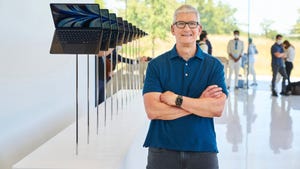Supercomm Review
ROADMs and pseudowires were major matters at Supercomm 2005; beaches and bowling also made the agenda
June 15, 2005

I have to say, although nothing truly revolutionary came out of Supercomm this year, meetings tended to be solid, informative, and generally upbeat. There were few briefings that left me thinking, "That's it, my last PowerPoint. I'm turning my energies to ending global warming!" In short, I survived my 15th (and last!) Supercomm.
This year’s Supercomm brought plenty of ROADMs, pseudowires, and even water parks and bowling (more on that later). Some technological progress was quite impressive. There seems to be significant momentum behind two technologies I've spent a good deal of time following since last Supercomm: namely ROADMs and MPLS.
NEC's ROADM reality
Plenty has been said about ROADMs this year, up and down, but our sense here at Heavy Reading about ROADM evolution is that the market is getting warm and will elbow up in about 18 months (see ROADMs Roll On). Wavelength selective switching is the bomb, but concerns that the subsystems are still immature and expensive are well founded. Everyone is in the ROADM game now, so hanging on to a lead is going to be tough, as all the systems I looked at were well designed, with individual merits to make them competitive in the critical year ahead.
One ROADM system I hadn't seen yet was NEC America Inc.’s4240 (see NEC Intros ROADM). It’s a solid system with a great set of specs. NEC has been awfully quiet over the past few years – it seems ages ago that it shocked the market by winning a major chunk of AT&T Corp.’s (NYSE: T) long-haul DWDM network. It wasn’t really able to follow that up with much in the U.S. market, and it wasn't until this year’s show that I felt a real sense of mission from NEC here in the States.
Not only does NEC have an impressive ROADM system (ROADM with wavelength selective switching, 1,200km distances, 40-Gbit/s transponders on the early roadmap), but it also has a multiservice switching platform that incorporates RPR, 10-Gbit/s transport, and some interesting scaleability options.
NEC’s multiservice box is lot like Corrigent Systems Inc.’s CM-100, which has rattled some cages in Japan by winning significant business at KDDI Corp. and threatening to land more with this key reference customer in hand. A number of vendors are quietly having to answer to Corrigent's success in Japan, and I guarantee you will see more RPR in the coming year as triple-play forces operators to look at ways to optimize packet transport in metro areas with a broad mix of service types.Pseudowireless?
Late in the afternoon on Monday, AT&T, BellSouth Corp. (NYSE: BLS), Hammerhead Systems Inc., Lucent Technologies Inc. (NYSE: LU), SBC Communications Inc. (NYSE: SBC), and other technical types got together for an informal discussion of just what it is that is so special about pseudowires. Too bad it's so hard to explain.
The session was bumpy, to say the least, proving that talking about pseudowires is a bit like passing a ball of mercury around. Pseudowires are at once incredibly simple (a virtual circuit created in IP/MPLS networks) and then... what? They can be extended beyond IP networks over Ethernet, ATM, or Sonet? They have their own unique OAM, identification, and protection? They are stitchable, switchable, signaled or patched? It’s not clear where the story leads.
The discussion quickly devolved into a back-and-forth of difficult-to-hear questions and difficult-to-understand answers, but a message did seem to crack through the muddle: RBOCs and AT&T understand pseudowires and are clearly committed to giving them a good run in the network. At Supercomm I heard from a variety of vendors – Cisco Systems Inc. (Nasdaq: CSCO), Fujitsu, Hammerhead Systems Inc., Lucent Technologies Inc. (NYSE: LU), Mangrove Systems Inc., Nortel Networks Ltd. (NYSE/Toronto: NT), Tellabs Inc. (Nasdaq: TLAB; Frankfurt: BTLA), to name a few – that pseudowires can be located in two general carrier frameworks: 1) Martini VPNs for convergence across a packet core, and 2) pseudowires for multiservice access networks, be they wireline or wireless. The second model is the most interesting one to watch these days. Talk to ten pseudowire technology vendors at Supercomm and the words "wireless backhaul" will show up at some point in the conversation. Everyone, it appears, cares a great deal about reducing the E1 and T1 charges wireless operators have to pay local telcos to get traffic from cell towers to switching centers.
It comes up so often that one begins to wonder if there is any other market out there for multiservice switches and access gear. The action is hottest in Europe today, as two forces have come together to create a demand spike: high leased-line prices and a quick transition to 3G infrastructure. This cuts the legs out from under mobile operator profitability, so they are keen on anything that packs as much traffic as possible onto their leased lines, or in same cases gives them a way to move off those onto cheaper, faster Ethernet backhaul connections.
Pseudowires have come to the rescue, with their mix of multiservice encapsulation, statistical muxing support, and a true agnosticism to underlying transport networks. Thus, as Mangrove Systems was quick to point out, as an operator moves from TDM-based 2G to IP-based 3G, it can bundle up TDM, ATM, IP, Ethernet, and any other traffic into pseudowires for backhaul across a single connection. With pseudowires at the ready, an operator can take its radio access network (RAN) and migrate it to 3G as it sees fit, with pseudowires providing the adaptation and integrated TDM grooming, ATM switching, and packet multiplexing providing the bandwidth efficiencies. I had to wonder, is this opportunity really so large, or have the traditional hotspots for multiservice switching (DSLAM backhaul, FR/ATM aggregation) just gone glacial?
Korea Telecom's water park
I mean no offense, but the animated short film provided by KT Corp. during the morning session of the International Engineering Consortium (IEC)'s Executive Forum left me with ample fodder for hallucinatory nightmares for years to come.
For those who didn't see it, here's the wrap: After opening his presentation with the rather chilling statement that KT has failed to grow revenues for broadband services since 2002 (the market is saturated, prices falling, capex still rising because of increased speed requirements...), the executive said that KT has decided it has to get creative in order to wring more dollars out of its existing customer base.
Now, KT’s ideas aren’t that radical – it’s the same-old value-added services pitched – but it’s marketed in an interesting way. It was the metaphor, the animation, the video – delivered with the earnestness of Colin Powell at the UN Security Council. Today's theme: the beach versus the water park. Two families set out for a refreshing dip in the water on a hot summer's day. One heads to the beach, the other to a water park.
The hapless beachgoers have perhaps one of the most miserable days imaginable – horrendous traffic, violent backseat kids, no parking (though an illegal spot is too tempting to pass up), so little space left on the sand that the family is forced to the grassy, littered fringe, where Dad steps on a broken bottle, gravely injuring his foot.
If that was not enough to convince us using "public" facilities is unforgivably bad judgment, their car gets towed and our family has to pay a mortgage-compromising fistful of cash to release their sedan from the impound lot. The color drains from the animation, withering to a final shot of the family on its way home, every face a mix of rage, dejection, and contempt (the infection on Dad's foot mercifully hidden from view beneath the dash).
Suffice to say, the family going to the water park has a fine time. Parking is a snap, cleanliness and efficiency are the order of the day, down to the proper application of sunscreen to prevent an itchy burn. Warm with color, our animated American family (in Korea, I guess), glows in the light of their faith in the "private" sphere, Dad's good sense, and the extraordinary "value" one gets from paying a bit extra.
What did this all add up to? The country-clubbing of Internet services, gated communities for surfers, complete with restrictive covenants and wary looks at newcomers on the block. I was perilously close to leaving my notebook on my chair and heading straight to graduate school in environmental science, but I held up. The crowd laughed through much of this, and our speaker from KT remained so resolute and stoic I couldn't help but feel he was as much a victim of this terrible, expensive bit of marketing as we were.
Anyway, that was Monday, I had a dozen meetings scheduled over the next three days and some kind of bowling thing going on at the House of Blues the next night (see LR Rules Supercomm Lanes). So I survived.
— Scott Clavenna, Chief Analyst, Heavy Reading
You May Also Like










